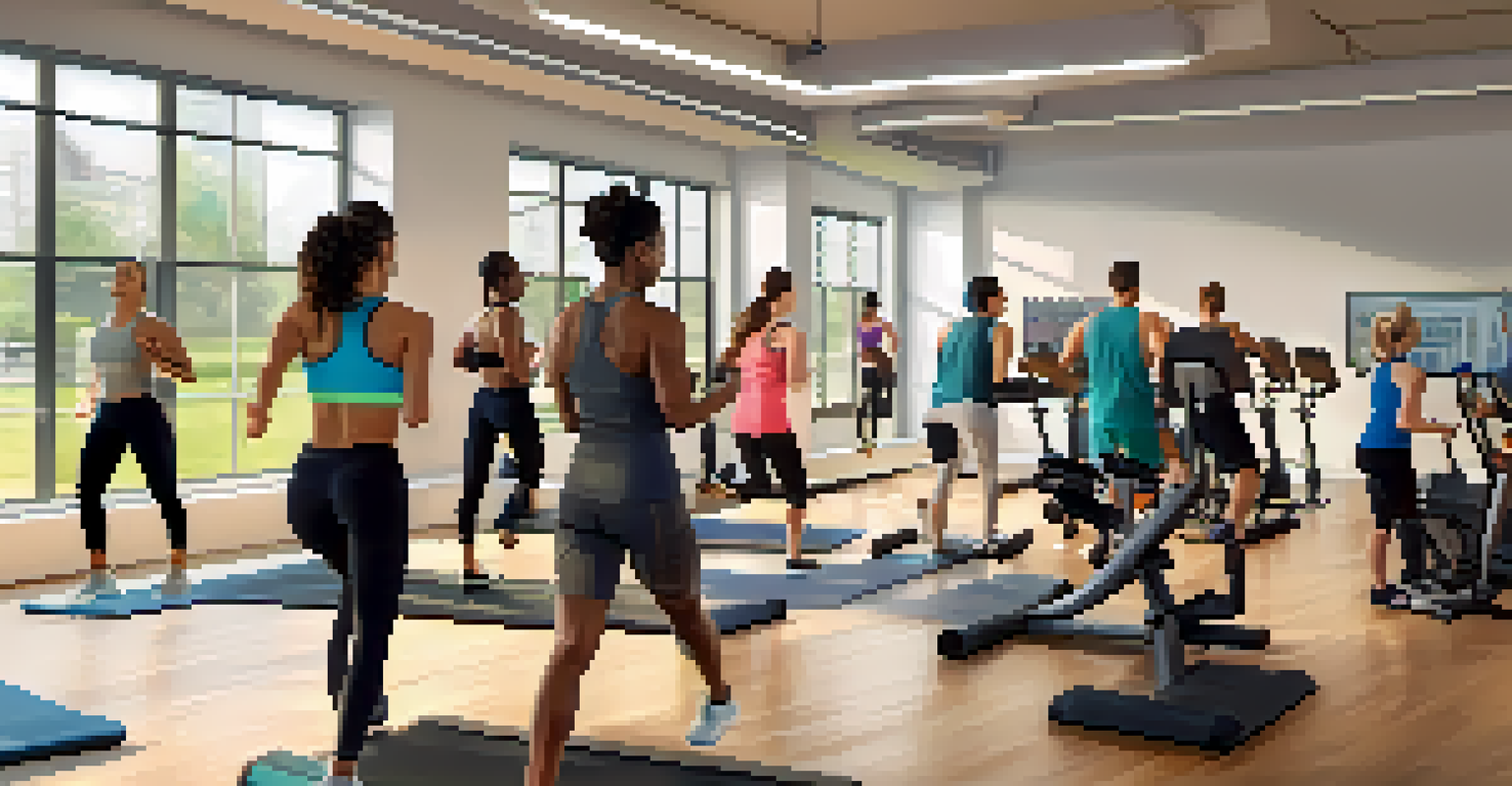The Role of Technology in Enhancing Your Fitness Journey

Understanding the Role of Technology in Fitness
Technology has become an integral part of our daily lives, and fitness is no exception. From wearable devices to mobile apps, these innovations are designed to help us reach our health goals more effectively. They provide us with the tools to track our progress and make informed decisions about our workouts and nutrition.
Technology is best when it brings people together.
For example, fitness trackers can monitor your heart rate, steps, and even sleep patterns. This data not only helps you understand your body better but also motivates you to stay on track. The insight provided by technology can be a game-changer, especially for those who struggle with consistency in their routines.
Moreover, technology has made fitness more accessible than ever. With online classes and virtual trainers, anyone can find a workout that suits their lifestyle without needing to step into a gym. This accessibility encourages more people to take charge of their health and fitness journeys.
Wearable Tech: Your Personal Fitness Assistant
Wearable technology, such as smartwatches and fitness bands, acts as a personal trainer on your wrist. These devices track various metrics, helping you monitor your performance and progress in real time. They can alert you when you're reaching your goals or even remind you to stay active throughout the day.

For instance, some wearables provide guided breathing exercises and stress management tools, promoting holistic well-being. This feature is particularly useful for individuals balancing a hectic lifestyle and needing a moment of mindfulness. The convenience of having such technology at your fingertips encourages regular use and engagement with your fitness routine.
Tech Enhances Fitness Tracking
Wearable devices and fitness apps provide real-time data and personalized insights to help users reach their health goals.
Additionally, many wearables offer social features, allowing you to connect with friends and family. This connection can create a sense of community, where you can share achievements and challenge each other. It’s like having a supportive workout buddy, even if they’re miles away!
Fitness Apps: Tailoring Workouts to Your Needs
Fitness apps have revolutionized how we approach exercise, offering a customized experience tailored to individual goals. Whether you're looking to build muscle, lose weight, or enhance flexibility, there's likely an app designed specifically for that purpose. These apps not only provide workout routines but often include instructional videos to ensure proper form.
The greatest wealth is health.
One popular example is MyFitnessPal, which not only tracks workouts but also helps monitor your nutrition. This dual functionality enables users to make informed dietary choices alongside their physical activities. By combining fitness tracking and nutritional guidance, these apps can lead to more sustainable lifestyle changes.
Moreover, many fitness apps integrate with other technologies, such as wearables and smart home devices. This interconnectedness creates a seamless experience where all your fitness data is accessible in one place, making it easier to stay motivated and engaged in your fitness journey.
Virtual Training: Fitness at Your Convenience
Virtual training has surged in popularity, offering flexibility and accessibility that traditional gyms can't match. With online classes and personal trainers available at the click of a button, you can work out from the comfort of your home or anywhere you choose. This convenience means you can fit workouts into your schedule without the added commute.
Platforms like Peloton and Beachbody On Demand provide a variety of classes ranging from yoga to high-intensity interval training. With so many options, you can easily find a workout that excites you, keeping your routine fresh and engaging. The ability to try different types of workouts without the pressure of a gym environment can also help build confidence.
Virtual Training Offers Flexibility
Online classes and virtual trainers allow individuals to exercise conveniently from home, making fitness more accessible.
Additionally, virtual training often includes community aspects, such as live classes with real-time interaction. This feature allows for a sense of camaraderie, as you can share your progress and motivate each other despite physical distances. It transforms solitary workouts into shared experiences, enhancing your fitness journey.
Nutrition Tracking: Fueling Your Fitness Goals
Nutrition plays a crucial role in any fitness journey, and technology has made it easier than ever to track what you eat. Apps designed for meal planning and calorie counting help you understand your dietary habits and identify areas for improvement. This awareness is essential for achieving your fitness goals, whether they involve weight loss, muscle gain, or overall health.
For example, apps like Lose It! or Cronometer allow users to log their meals effortlessly. By analyzing what you consume, these platforms can provide valuable insights about your macronutrient distribution and overall caloric intake. This information can guide your meal choices, ensuring you're fueling your body effectively.
Moreover, some nutrition apps offer features like barcode scanning for packaged foods, making it incredibly easy to log meals. This seamless integration encourages users to stay accountable and mindful about their food choices. When you know exactly what you're putting into your body, it becomes easier to align your nutrition with your fitness objectives.
Community and Social Features: Finding Support
One of the most significant advantages of technology in fitness is the sense of community it fosters. Many fitness platforms incorporate social features, allowing users to connect, share experiences, and cheer each other on. This support can be incredibly motivating, especially during the tough days when you might feel like giving up.
For instance, applications like Strava allow users to share their runs and workouts, creating a competitive yet supportive environment. You can celebrate personal achievements, like hitting a new personal record, and encourage others in their journeys. This sense of belonging can make a significant difference in maintaining motivation and commitment.
Community Boosts Motivation
Social features in fitness platforms foster a supportive environment, encouraging users to stay committed to their fitness journeys.
Additionally, online forums and social media groups dedicated to fitness provide spaces for sharing tips, advice, and success stories. Engaging with others facing similar challenges can inspire you to push through obstacles. The power of community in fitness is undeniable, and technology helps bridge the gap, connecting us in our pursuit of health.
Future Trends: What’s Next in Fitness Technology?
As technology continues to evolve, the fitness industry is poised for even more exciting innovations. From advanced AI personal trainers to virtual reality workouts, the future of fitness technology looks promising. These advancements aim to make fitness more engaging and personalized than ever before.
One emerging trend is the integration of artificial intelligence in workout programs. AI can analyze your performance data and adjust workouts in real time, ensuring you’re always challenged while preventing injury. Imagine having a personal coach that adapts to your needs as you progress – that's the future of fitness technology.

Moreover, the rise of immersive technologies like virtual and augmented reality is set to transform how we experience workouts. Envision yourself climbing a mountain or dancing in a vibrant city – all from your living room. These experiences could make exercise feel less like a chore and more like an adventure, encouraging even more people to get moving.